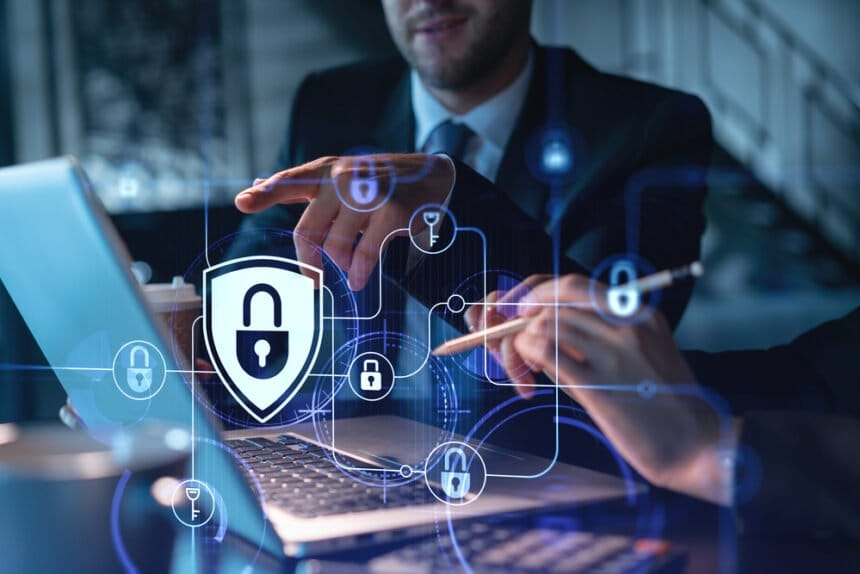Cybersecurity is essential for any organization looking to stay competitive in today’s digital world. However, the average data breach cost is staggering—$3.86 million—and organizations are constantly at risk of cyber-attacks and malicious actors. In order to protect your business from these threats, it’s essential to understand what digital transformation entails and how you can safeguard your company from cyber risks.
This article will outline key steps companies should take to have a competitive advantage by adopting new technologies and incorporating them into their digital transformation strategy. Read on and learn how to keep your data safe and secure while streamlining your business processes in this digital age.
Understanding Cyber Risk
Understanding cyber risk is essential for organizations looking for successful digital transformation initiatives. Cyber risk refers to any potential threats that could compromise an organization’s digital products, from malicious actors or hackers to data breaches and phishing scams. In order to protect against these risks, organizations must invest in the latest security protocols and technologies to safeguard their legacy systems and have successful business outcomes.
What is cyber risk?
Cyber risk refers to any potential threats that could compromise an organization’s security from malicious actors or hackers. Cyber risks can range from cyber espionage and theft of sensitive data to cyber warfare and financial fraud.
Organizations must be aware of the latest trends in order to implement the most effective cybersecurity strategies. Such strategies should include awareness and prevention, detection, and response plans that you can quickly activate in the event of an attack. Additionally, organizations should ensure they stay up-to-date on all relevant security protocols to minimize the risk of a breach or cyberattack while on their digital transformation journey.
Types of cyber threats
Here are some of the most common cyber threats today:
- Malware – Malware is malicious software which is designed to cause damage, disrupt, or gain unauthorized access to computer systems. It is typically spread through downloads, email attachments, websites, and other online sources. Hackers can also use malware to steal personal data, hijack resources, and carry out cyber attacks.
Malware is increasingly sophisticated and capable of infecting devices without users’ knowledge. It can attack computers and mobile devices and can even disguise itself as a legitimate app. As a result, organizations need to implement the latest security protocols, including anti-malware software, firewalls, and regular patches. Additionally, staff should be trained in recognizing malicious emails and links.
- Ransomware – Ransomware is malicious software that encrypts data or systems and then demands payment to decrypt or restore access. It is becoming increasingly prevalent among cybercriminals due to its ability to quickly generate significant profits with minimal risk.
The most common form of ransomware is ransomware-as-a-service, whereby attackers offer a range of tools and services to support ransomware operations. This has enabled even inexperienced cyber criminals to launch successful attacks, making it more critical than ever for organizations to take the necessary steps to protect their data. New digital technologies such as artificial intelligence, data analytics, machine learning automation, and the Internet of Things (IoT) may seem like a breakthrough for decision-making, but they are not bulletproof.
In addition to deploying robust security protocols, organizations should also ensure that all employees are aware of the risks posed by ransomware and are well-versed in recognizing malicious emails and links. Additionally, it would be best to do regular backup workflows on your digital transformation efforts.
- Distributed Denial of Service (DDoS) – DDoS is a form of attack in which multiple internet-connected systems flood a target with traffic after being compromised, making it unavailable for legitimate users. Hackers use DDoS attacks to overwhelm a website or online service with requests from multiple sources, causing it to crash and decreasing operational efficiency. This form of attack may degrade customer experience because it will render the apps useless.
These attacks are often conducted using a network of infected computers known as botnets, which are programmed to send large amounts of traffic to the target. DDoS attacks can cause significant disruption and damage to an organization’s digital business operations and brand reputation. They may even drag down the business value. And in some cases, it might even mess up the whole ecosystem.
Organizations must protect against these threats by deploying effective security protocols such as firewalls and anti-DDoS software. Additionally, it would help if you upgraded to the latest security patches to ensure that systems are up-to-date with the latest security measures.
- Spam and phishing – Spam and phishing are done via automation. They are two of today’s most prevalent cyber threats. Spam is bulk email that is sent out indiscriminately to a large number of recipients, often containing malicious links or malicious attachments. Phishing is a social engineering attack wherein attackers attempt to gain access to sensitive information, including usernames, passwords, and credit card details, by sending malicious emails or links.
Organizations must take steps to protect against these threats by deploying effective security protocols such as email filtering and spam-blocking software. Additionally, staff should be trained to recognize suspicious emails and links to identify potential attacks and respond appropriately. Make sure to perform these checks before you save emails to PDF or other similar tasks.
- Corporate Account Takeover (CATO) – Corporate Account Takeover (CATO) is a form of cyberattack in which an attacker gains access to a company’s accounts and uses them to steal money or data. In this type of attack, the attacker usually gains access to company accounts via phishing emails or malicious links sent to employees. Once they gain access, they can conduct malicious activities such as transferring funds, changing passwords, and accessing sensitive data.
Organizations should take steps to protect against CATO attacks by deploying effective security protocols such as two-factor authentication, limiting access privileges, and monitoring suspicious activity. Additionally, all staff members should be trained to recognize phishing emails and links to identify potential attacks and respond appropriately.
Developing a Cybersecurity Business Strategy
Here are some cybersecurity strategies startups and big companies can do to protect their data with their digital transformation projects:
Conduct a risk assessment
Risk assessments are critical to any organization’s cybersecurity strategy and roadmap. A risk assessment involves:
- Identifying areas of vulnerability.
- Analyzing potential threats and their impact.
- Developing strategies to mitigate those risks.
The first step in conducting a risk assessment is to identify potential threats. You can do this by examining the current security landscape and looking for areas of weakness. Once potential threats have been identified, the next step is to analyze their impact and determine the best mitigation strategies. This may involve creating new security policies and procedures, implementing more robust authentication systems, or using data encryption techniques.
Finally, organizations must ensure that these strategies are regularly monitored and updated as necessary. You should conduct a risk assessment regularly to ensure the organization is as secure as possible.
Identify critical assets
Identifying critical assets is essential for any organization to ensure its data is not compromised by malicious actors. Critical assets are defined as data or systems which are most important to an organization and require the highest level of security. This could include customer information, financial records, intellectual property, and confidential documents.
Organizations must take steps to identify their critical assets and determine the level of protection needed. This can involve thoroughly auditing their current systems and data to determine what is most valuable. Additionally, it would be best to reimagine security protocols for determining who has access to the data and how it is stored.
Finally, organizations must ensure that all staff members are trained on proper security procedures to recognize potential threats and respond appropriately. By taking these steps, organizations can ensure their critical assets are protected from malicious actors while streamlining their business needs.
Establish security controls
Establishing adequate security controls is crucial in protecting an organization’s data from malicious actors. It would help if you tailored security controls to the organization’s specific needs and can include authentication systems, encryption technologies, access control policies, and real-time malware scans. These controls help protect against external threats while preventing internal company system misuse.
Additionally, during a business transformation, organizations should establish processes for continually monitoring and evaluating their security controls. In today’s digital environment, where cybersecurity talents are in high demand, organizations facing challenges in securing the right professional staff for these tasks can leverage online platforms like cybersecurityjobs.com to find the skilled personnel required to enhance their security measures during the digital transformation process. This will help ensure the controls are up-to-date with the latest threats and technologies. Organizations can also regularly conduct penetration tests to verify that their systems are secure against malicious actors and have a solid change management system to promote a safer overall user experience.
Understanding Data Protection
It is critical to understand the fundamentals of data protection. This ensures that you avoid data loss and theft through your modernization efforts.
Encryption and data masking
Encryption and data masking are essential measures for data protection. Encryption is a process in which information is encoded to be read only by those with an authorized decryption key. It uses algorithms to scramble data, making it unreadable to anyone without access to the decryption key.
Data masking is a similar process that replaces sensitive data with simulated information, allowing organizations to use the data for testing and development without compromising its security. You can also use this to limit access to sensitive data by obscuring its original value. Both encryption and data masking helps protect an organization’s confidential data from malicious actors.
Data backup and recovery
Data backup and recovery are crucial parts of data protection. It involves regularly backing up the organization’s data to ensure that it can be restored in case of an emergency. This can include creating backups on external drives, cloud storage, and other services. Additionally, organizations should establish protocols for regularly testing the integrity of their backups to ensure they are tested and up-to-date.
Organizations should also have a plan in place for recovering data from any backups that may become corrupted or lost. A solid disaster recovery plan will help ensure that the organization can quickly recover its data and return to normal operations. Another option is adopting new products, such as cloud computing technologies, which ensure you don’t need to worry about manual data backups.
Finally, organizations must ensure all staff members are trained on proper data backup and recovery procedures. Doing so will help ensure that data is adequately backed up and protected in an emergency.
The Bottom Line
Data protection is essential for modern organizations and requires a comprehensive approach. Organizations must conduct an audit to identify their critical assets and establish security protocols, encryption technologies, access control policies, malware scans, data masking measures, and backup recovery plans.
Finally, all staff members should be trained on proper security procedures to recognize potential threats and respond appropriately and quickly. By taking these steps seriously and investing in the tools and systems needed to protect their data from malicious actors, organizations will have a better chance of staying safe online.











